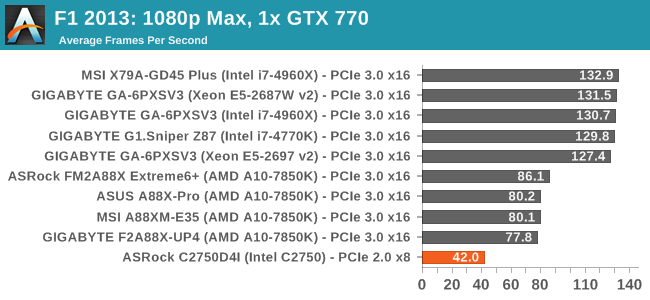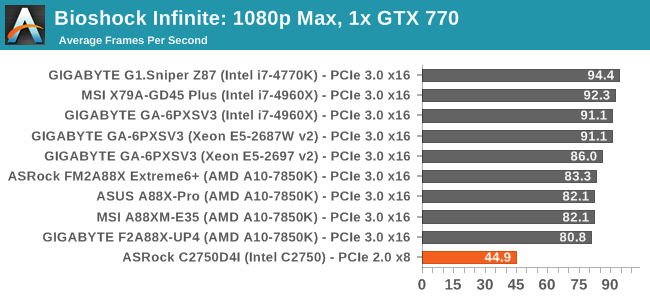ASRock Rack C2750D4I Review: A Storage Motherboard with Management
by Ian Cutress on April 29, 2014 9:00 AM EST- Posted in
- Motherboards
- Storage
- Atom
- ASRock
- Silvermont
- Enterprise
- server
- Avoton
As an interesting dynamic to our testing, it has been requested that we see how well the C2750 does in our discrete GPU benchmarks. The combination of a slower CPU and limited PCIe bandwidth will be the major culprit in almost all our benchmarks, although Tomb Raider is at least on an even keel. Most of our benchmarks show a 30+ FPS frame rate, if you are willing to pair a large GPU with the C2750D4I. Again, we are currently testing other 25W platforms to provide more applicable competition for this platform.
F1 2013
First up is F1 2013 by Codemasters. I am a big Formula 1 fan in my spare time, and nothing makes me happier than carving up the field in a Caterham, waving to the Red Bulls as I drive by (because I play on easy and take shortcuts). F1 2013 uses the EGO Engine, and like other Codemasters games ends up being very playable on old hardware quite easily. In order to beef up the benchmark a bit, we devised the following scenario for the benchmark mode: one lap of Spa-Francorchamps in the heavy wet, the benchmark follows Jenson Button in the McLaren who starts on the grid in 22nd place, with the field made up of 11 Williams cars, 5 Marussia and 5 Caterham in that order. This puts emphasis on the CPU to handle the AI in the wet, and allows for a good amount of overtaking during the automated benchmark. We test at 1920x1080 on Ultra graphical settings.

| F1 2013, 1080p Max | ||
| NVIDIA | AMD | |
| Average Frame Rates | ||
| Minimum Frame Rates | ||
Bioshock Infinite
Bioshock Infinite was Zero Punctuation’s Game of the Year for 2013, uses the Unreal Engine 3, and is designed to scale with both cores and graphical prowess. We test the benchmark using the Adrenaline benchmark tool and the Xtreme (1920x1080, Maximum) performance setting, noting down the average frame rates and the minimum frame rates.

| Bioshock Infinite, 1080p Max | ||
| NVIDIA | AMD | |
| Average Frame Rates | ||
| Minimum Frame Rates | ||
During our Bioshock Infinite test there was a clear stutter during the benchmark that would make the game completely unplayable.
Tomb Raider
The next benchmark in our test is Tomb Raider. Tomb Raider is an AMD optimized game, lauded for its use of TressFX creating dynamic hair to increase the immersion in game. Tomb Raider uses a modified version of the Crystal Engine, and enjoys raw horsepower. We test the benchmark using the Adrenaline benchmark tool and the Xtreme (1920x1080, Maximum) performance setting, noting down the average frame rates and the minimum frame rates.

| Tomb Raider, 1080p Max | ||
| NVIDIA | AMD | |
| Average Frame Rates | ||
| Minimum Frame Rates | ||
Tomb Raider is a game that seems to move almost entirely onto the GPU, not worrying much about the CPU or the DRAM attached to it.













85 Comments
View All Comments
S.D.Leary - Tuesday, April 29, 2014 - link
Actually, for the SMB/Home version I was thinking more along the lines of keeping all the management, but dropping the TPM.Dropping BOTH extra SATA switches. (No real need for these on a home Media Server, and honestly for many/most SMB, four 6TB drives would be more than enough)
Updating USB to 3.1 status
A digital video output.
Dropping the COM port
Thunderbolt 2 for external expansion (that way a SMB that was growing could add a storage chassis if needed)
And for Silverstone, a chassis with similar capabilities to the DS380, but with the following changes...
Drop 3.5" support. Ideally 4 Hot Swap 2.5" external bays, and one or two internal 2.5" bays.
An option for a Slim Optical drive.
Preferably a horizontal orientation to fit into an A/V setting.
Support for double wide normal graphics cards. This would probably necessitate a riser and horizontal orientation of the card.
Ian! A question for you. Do you have something that could test real time transcoding of Audio and Video? Both with and without a GPU?
SDLeary
Computer Bottleneck - Tuesday, April 29, 2014 - link
I like the idea of the consumer version as well.Make mine a C2550 and no additional SATA controllers. (SOC has six native SATA).
LastQuark - Monday, May 5, 2014 - link
You're looking at the wrong board. Check Bay Trail solutions. It will be perfect for your needs.swizeus - Tuesday, April 29, 2014 - link
Interesting as how Anandtech includes gaming benchmark for a storage centric motherboard, and with a decent card, it still be able to cope. What can you expect from a 25W CPU thoughLastQuark - Monday, May 5, 2014 - link
+1. It was a gross oversight of what this board is intended for.-=Hulk=- - Tuesday, April 29, 2014 - link
1. All recent Atoms (including Avaton's) support hardware AES acceleration:http://ark.intel.com/products/77987
2. 43W idle for the 5350??? What the hell??? I think your values are totally wrong....
50W for the C2758??? Look at that test with a similar Supermicro Mini-ITX motherboard:
http://www.servethehome.com/intel-avoton-rangeley-...
Ian Cutress - Tuesday, April 29, 2014 - link
Values aren't wrong, but the PSU is inefficient. Those values are also a full system build. I have to keep the same power supply across reviews for meaningful comparisons on the same efficiency curve, which I mention in the blurb above the power readings. I also mention that due to that fact, it's more a qualitative comparison than a quantitative.DanNeely - Tuesday, April 29, 2014 - link
I understand why you're using the same PSU for all your tests. But for really small/low power systems I'd suggest adding a second power test with a much smaller PSU, similar to how the old cast thermal tests for small enclosures were often done with both a big high power GPU and a small lower power one. The 1250W monster would allow for direct comparison with high power gaming systems; a second number from a ~250W PSU would provide a second number that would be more inline with typical use.watersb - Tuesday, April 29, 2014 - link
Wow! Thanks for writing about this one! I build small-office storage servers, and this might be exactly what we need!watersb - Tuesday, April 29, 2014 - link
"Users have been reporting that in Linux and FreeBSD, high intensity read/write workloads cause the controller to reset and elements to any software array are lost."Hmm. Not good. I see this with Sil3132 controllers, too. The PCIe x8 slot would let me install a modest controller like the old Intel/LSI SASUCI8, but that push the system price back into SuperMicro territory.